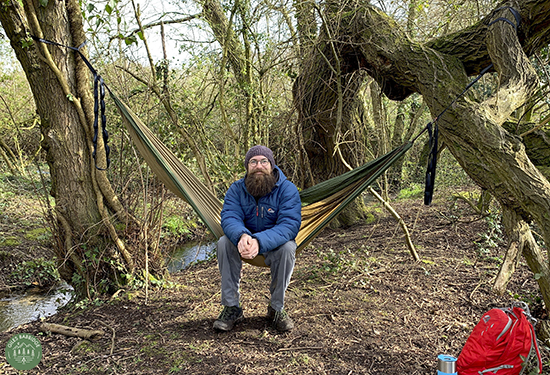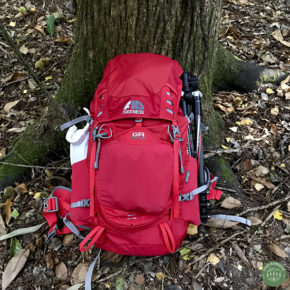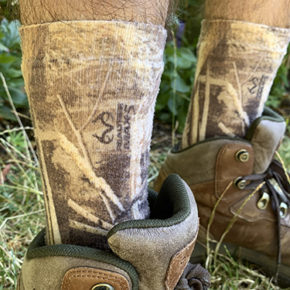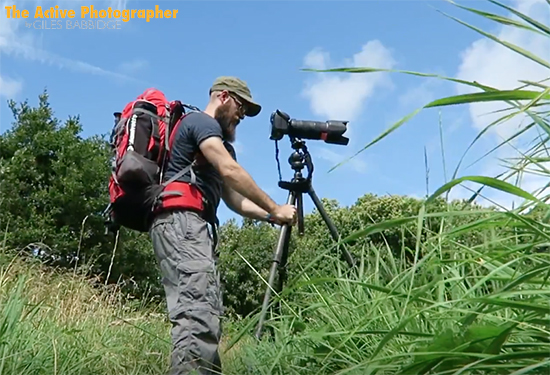If there’s one thing I wish the outdoors community in the UK embraced more, it’s hammocking. Specifically, I think it would be great if more people were encouraged to simply have a go, if only for just an hour or two on a fine day.
For those of you who already know what all the fuss is about – and who head out for a hang regularly – the name ENO (Eagles Nest Outfitters) will no doubt be very familiar.
Some time ago (this is a long-term, somewhat delayed Test/Review due to the pandemic and other factors), I was given the wonderfully basic setup of their SingleNest hammock with Atlas Suspension System straps to have a play with.
I was given the two-tone green version with black straps. This won’t be everyone’s cup of tea (in which case, you can choose from a wide range of other subtle and not-so-subtle colourways) – but it was perfect for me, as it’s always my intention to blend in as best I can and feel more at one with nature.
To say I’ve put this setup through its paces would be an understatement. It’s accompanied me through all weathers in all seasons and has even found it’s place in The Babbin. I’ve used it set up on its own as well as in various configurations with other hammocking gear such as tarps, underquilts/sleeping bags, ridgeline modifications and more.
And naturally, it has been used as my base when working in my ‘outdoor office,’ as well as for recreation.
Not surprisingly, it’s the woods which have been my playground for this Test/Review. So the question is – how does the setup fare in this most traditional of hammock environments?
The simple answer – incredibly well!
Weighing in at 447g (15.8oz) for the hammock and 341g (12oz) for the pair of straps, and with an approximate pack size (as supplied) of 9cm x 14cm and 9cm x 13cm respectively, the advantages are clear to see when it comes to the weight-to-bulk ratio.
The SingleNest itself is constructed of FreeWave® 70D Nylon Taffeta, and is a 9.5ft (2.9m) gathered-end model. It comes with a couple of really sturdy (non-climbing) carabiners pre-attached – one at either end – and offers a maximum weight load of 400lbs (181kg).
What this translates to in real terms is a very comfortable, soft and lightweight arrangement with just enough give that conforms nicely to the shape of your body, whilst offering a reassuring sense that it’s going to hold your weight over extended periods of time. Also worth noting are the breathability and fast-drying qualities, which are appreciated for all year-round use.
In practise, I’ve been able to comfortably remain in the hammock whilst leaning over to operate stoves for cooking meals and making drinks. Likewise, accessing my backpack has posed no problems. There has simply been very little swinging movement and certainly no threat of tipping out (which is, truthfully, just as much about poor technique as it is hammock construction!).
Sitting up to eat and drink is hassle-free in the SingleNest and it goes without saying that I’ve found no issue when sleeping either.
For convenience, the whole thing stuffs into an always-attached pouch featuring a draw cord and quick release buckle. This does a good job at keeping things nice and compact, with the added benefit that you then have somewhere convenient to place your phone, water bottle etc when lying back, relaxing.
In all the time and conditions I’ve used the SingleNest, not once have I encountered a stitch out of place. This is especially impressive when you consider the amount of pressure applied whist getting in and out, repositioning oneself and repeated packing/unpacking.
So let’s now take a look at those Atlas Suspension System straps…
Constructed of 1000D Polyfilament Webbing, each one measures 9ft (2.7m) x 2.5cm, features 15 sewn-in loops and the pair are supplied in a draw cord pouch.
I’ve found them to be super-durable and incredibly abrasion resistant. In fact, the only real sign of use is a little fraying around the edges of the attached info labels which tell you that each strap can hold a maximum weight of 200lbs (90.5 kg).
The simplicity with which you can set up your hammock using these straps is, frankly, ridiculous. Pick a tree, wrap a strap around and feed it back through the end loop and tighten up. Repeat with the second strap on another tree. Select the loop attachment points for your hammock along the strap and clip in the carabiners. Done.
Super convenient – yes. Quick to do – yes. But in real-world scenarios, such as when you just want to bed down for the night after a long day of hiking or you need to set up under a tarp in the cold, pouring rain, this is when the system really comes into its own.
The barrier to entry – that is, the initial cost of purchasing a simple setup which is going to last, unlike cheaper knock-off alternatives – is really quite low when considered alongside, say, a comparable tent arrangement. At the time of writing, a quick search online brings up average current prices £35-45 for a SingleNest and £25 for a set of standard Atlas Straps.
For the novice hammocker, I would gladly recommend this ENO arrangement as a starting point. Strong, reliable, comfortable – the three qualities you need in a hammock arrangement are right here in a quick and easy-to-use bundle.
—
It’s worth noting that both the SingleNest and Atlas Suspension System straps have been subtly tweaked in the current line-up. If you’d like to find out more, you can take a look at the ENO website here.


















